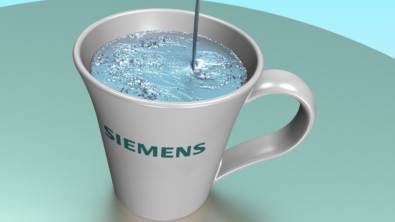Yeah, coffee helps – but have you tried computational electromagnetics?

Coffee and computational electromagnetics? How does that go together? Well, it all started with the covid19 lockdown. I came across the recipe of a new trendy caffeine-based drink, interestingly dubbed the “quarantine coffee drink”: the Dalgona Coffee, a kind of inverse cappuccino. I am Italian and I tend to become a bit emotional when the topic is coffee, so I decided to sacrifice myself and test the drink.
In order to prepare it, you need to whip some instant coffee with sugar and warm water until it gets foamy and firm. Easy-peasy. I got a spoon and started manually whipping the mix. After almost 8 minutes of disappointing cardiovascular activity and elbow grease, I declared the experiment failed. I double-checked the recipe and I noticed that “an electric hand-mixer was strongly recommended”.
Electromagnetics is your friend
Electric motors are a fine invention, really. By combining cleverly arranged electric wires with permanent magnets, they deliver the right torque and rotational speed for your job. Interestingly, they are the core component of several of the devices you may find useful during a quarantine (most notably hair clippers). For instance, my neighbors seem to enjoy playing with two types of electric motors exactly when I need some focus: the heavy-duty drill machine and the lawnmower.
You can’t use an electric frother if you haven’t got electric power at hand. Generators far away from you produce electric power, which is then distributed at high voltage via a grid of cables. Converters and transformers in your town’s substation step down the high voltage before distributing the power to households. Circuit breakers control switching/commutation operations. And for your safety at home, fuses take care of dangerous voltage spikes and short-circuits.
Computational electromagnetics is your friend
What I have always found fascinating about this zoo of different applications is that their diverse working principles are a direct incarnation of the same set of physical laws. Herr Ernst Werner von Siemens understood that very well and made a huge business out of it.
Despite their elegant and reasonable appearance, the equations describing those phenomena need to be handled with care. Textbooks are full of worked examples in simplified geometries, however, in real life, simple geometries are the exception, not the rule. No wonder a set of methods had to be established that caters for the increasingly complex real-world problems: computational electromagnetics.
On top of that, consider that most of the forefront innovation nowadays is played on the field of multiphysics. In a multiphysics simulation, computational electromagnetics is not a stand-alone effect. On the contrary, it has an impact on the thermal, fluid and structural properties of the device and vice versa. So, long story short, numerical simulations are an essential tool for your advanced analyses.
Simcenter STAR-CCM+ is your friend
Simcenter STAR-CCM+ is a multi-purpose CFD tool with expanding multiphysics capabilities. In a single integrated user interface, users can utilize a full suite of coupled physics models to build a high-fidelity digital twin of their real-life application. In particular, Simcenter STAR-CCM+ offers dedicated models for electromagnetic analysis at low frequency, namely when the wavelength of the fields is larger than the size of the domain under investigation (for instance, for devices of less than ~1 m, the low-frequency range is below ~500 MHz).
Both frequency and time-domain solvers are available, in 2D, 2D axisymmetric and in 3D. The user can choose between a Finite Element (FE) based and a Finite Volume based numerical formulations. The former is essential to avoid spurious solutions when your simulation include ferromagnetic materials. The latter is useful for plasma simulations with no ferromagnetism (e.g. high voltage circuit breakers).
The FE Magnetic Vector Potential model – the cutting edge of Simcenter STAR-CCM+’s electromagnetic suite – enjoys the choice of both a direct and an iterative multi-grid solver. The iterative solver is particularly advantageous for large problems (tens of millions of degrees of freedom). It shows indeed excellent performance and scalability thanks to Simcenter STAR-CCM+’s High Performance Computing framework.
Multiphysics is a powerful tool for highly predictive analyses of the thermal behavior of electric machines. For highest fidelity, it is critical to be able to recruit all necessary physical models in a coupled manner. This is achievable within one simulation file in Simcenter STAR-CCM+. Simulation of a BMW i3 motor by Kaushik Illa.
Coupled multiphysics is your friend
The ability of Simcenter STAR-CCM+ to couple several physics models in one single environment is one of its major strengths.
Consider, for instance, those simulation experts who need to account for the effective cooling of an electric machine. This is an essential step in the development chain of a robust and high-performance electric motor (see also our on-demand Webinar 1 and Webinar 2). While electromagnetic losses provide the heating terms, detailed cooling simulations could involve advanced multiphase analyses (e.g. oil-spray cooling). Therefore a single, integrated software environment with all the required physics significantly facilitates the job of the simulation experts.
Similarly, designing a reliable circuit breaker often requires detailed simulations of complex physical phenomena, involving radiation, electrode motion and fluid dynamics. Take a look at some publications outlining the power of computational electromagnetics in Simcenter STAR-CCM+ here or here.
Typical low frequency, multiphysics applications that you can perform with Simcenter STAR-CCM+ include:
- Electric machines (motors, transformers, etc) and their thermal management
- Magnetohydrodynamics and plasma arcs (circuit breakers, relays, welding devices, plasma torches) – see also this blog post
- Actuators and loudspeakers – more in this blog post
- Problems involving coupling with Solid Stress to assess mechanical strength under magnetic loads in short-circuit events
- Induction heating and stirring
- Ohmic heating: busbars, fuses, etc
- Sensors and flow meters
You can find further specifications on this fact sheet.
Coffee is your friend too
Maybe I fell in the trap of the powerful lobby of the electric hand-mixer industrialists who invented the Dalgona coffee. The fact is that I bought an electric hand-mixer. However – ironically – my second attempt too was disappointing because, well, I over whipped it and the final consistency was too thick to mix well with the milk… Anyway, my final verdict on the recipe is that it is – in spite of its non-Italianness – delicious! Just go easy on the sugar.
Now grab your mixer, make a Dalgona and enjoy it together with this on-demand webinar “The high-fidelity digital twin: Simulate reality no matter how complex the physics or geometry“.


